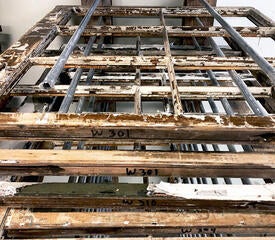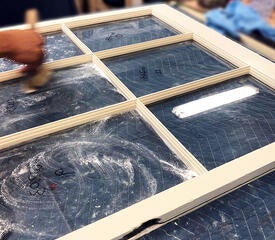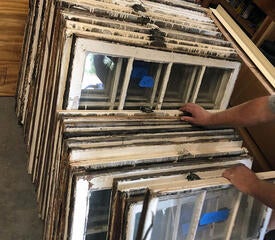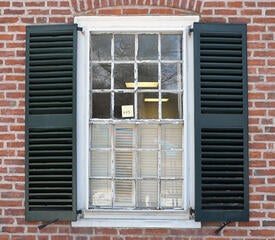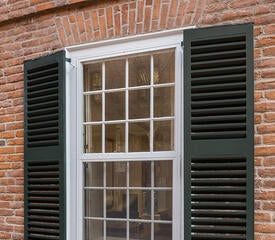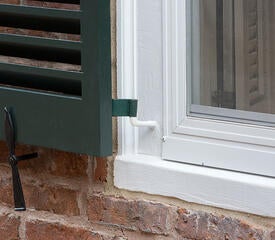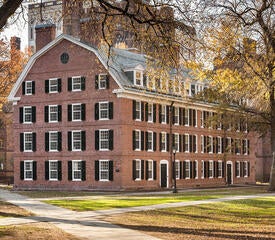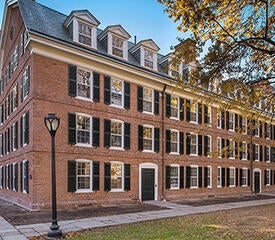We want to hear from you! Take the survey.
How do you use It’s Your Yale? How can it be improved? Answer for a chance to win Yale swag.
What does a historic building need from its windows? Answered.
February 18, 2022
Through longstanding research and practice, Brian Cooper has become a leading resource for the accurate restoration of period windows, and he generously shared his expertise with nearly 90 university colleagues via video conference on Wednesday, January 26.
As part of an ongoing series of seminars on sustainable planning, design, and construction, the Office of Facilities welcomed Brian to speak to each of those processes framed through a building’s windows. Brian is the President and CEO of the Cooper Group and has more than 40 years of experience in historic window restoration, including several projects at Yale.
His continuing education session considered how each building can be carefully analyzed for an upgrade of its windows and completed without losing aesthetic or functional integrity. “The challenge is to build a window that looks authentic and offers high performance,” said Brian.
Restoration and replication
According to him, window restoration can be broken down into two categories: replication, which aims to make windows as accurate to the original construction as possible while introducing contemporary energy efficiencies, and restoration, where the original materials comprising a window are revitalized and protected.
“One of the primary issues to overcome during restoration is the mitigation of lead paint and removal of glazing and caulking that contain asbestos,” said Brian. “To complete that process for wood constructions, we use large steam ovens to soften the materials without creating dust and to minimize breaking the historic crown or cylinder glass upon removal.” Brian added, “this process also kills any bugs that have burrowed in the wood.”
For steel configurations, Brian said “there is rust to mitigate and that the windows are usually heavy and large. We found that aqua blasting is safer than sandblasting as a way of containing lead and utilizing that technology.”
Revisiting the replication process, Brian said,
“our goal is to build a window that looks as it did when the building was first constructed. The challenge is to make that window highly efficient. Over time, my colleagues and I realized that glass was the most important component. It was the one place where we can implement modern technology and offer major energy savings.”
Brian described achieving this efficiency by assessing how much heat can be reflected into the building in a northern climate and the opposite, solar heat gain, which reflects heat out of the building in a southern climate. Inert gases like Argon and Krypton are deployed between glass panes depending on the required density and coated Mylar technology, which suspends a thin film in a window’s interior airspace, creating added insulated chambers between the glass and spacer.
“We found that stainless steel was the best product to hold the interior components of an insulated glass unit together. Its thermal convection performed better than aluminum,” stated Brian. “We also realized that a single seal would not offer enough longevity and applied warm edge technology to activate both sides of each spacer to create the best seal, which minimized heat transfer around the perimeter of our windows.”
Evolution of window design
The evolution of European-inspired window design in the Americas began with a fixed or casement-style. In the seventeenth century, small diamond-paned windows illustrated the rarity of glass as well as the value of iron for fasteners and slaked lime to reinforce mortar. By the eighteenth century, twelve over twelve, eight over twelve, and six over six single-hung windows with a bottom sash became more popular.
Window function reached a crescendo in the nineteenth century with the introduction of a double-hung window, which Brian noted “was the single biggest breakthrough in window design in three hundred years.”
Through a video demonstration, Brian positioned the top and bottom sashes of a new double-hung window towards the center of its frame, allowing for hot air to exit through the top opening and cold air to enter through the bottom—creating convection.
Preparing for climate change
While Brian’s efforts have long been focused on achieving an optimal level of energy efficiency through his products, he stressed “that the best way to deal with climate change is to mitigate how much sunlight your window allows into the building. Controlling solar heat gain is the most important single aspect for designing a window for climate change.”
A major consideration is light transmission. The advantage of using modern technologies as an application for historic windows supplies flexibility, where the various types of Mylar film can be used between glass panes based on locale. The Mylar, which is three-thousandths of an inch thick, is covered with low-e coatings on both sides of the film. Distinct coatings offer control of solar heat gain and provide maximum reflectance of heat back into the building, allowing you to specify different films for the north and south-facing façades of a building.
Sourcing sustainable products is another way to combat a changing climate. Most windows for the market are still made from wood, and Brian noted the use of Accoya®, which he said “is a plantation pine that is fully renewable.”
Accoya® is a rapid-growth pine with large growth rings and is porous, allowing for acetylation of the wood through a vacuum-like process. Upon receiving this treatment, the wood no longer exchanges hydrogen molecules and does not contract due to water loss or expand due to absorption. Since one of the three elements that cause deterioration was removed from this equation, the wood will not rot.
At Yale
Brian discussed a few highlights of his team’s work for Yale, including its oldest standing building, Connecticut Hall, completed in 1750. “We were given the task of restoring the existing wood windows, and in this situation, documentation was key. Each window, piece of glass, sash, and frame were photographed, evaluated, and numbered,” stated Brian. “The sashes were taken back to our shop to be carefully dismantled, then fully restored.”
Through this process, Brian’s team noticed something usual: the caulking was a historic material used in shipbuilding called oakum. This fiber-based product was applied between the planks of large ships during the eighteenth century, which aligns with the fact that New Haven was a port city at that time.;
“You could still smell the oakum. It has a unique, tar-like odor,” said Brian. “It was interesting to see that historic oakum was still in place and still doing its job.”
Photo credits for Aaron Usher and the Cooper Group



